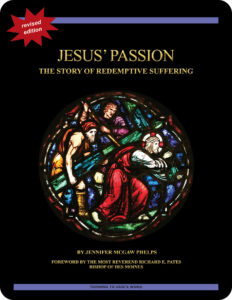 Jesus’ Passion:
Jesus’ Passion:
The Story of Redemptive Suffering
Lesson 4 Via Dolorosa: The Way of Sorrows
the Gospel According to Luke 23:26–32
the Gospel According to Mark 15:21–22
the Gospel According to Matthew 5:43–46
the Gospel According to John 10:14–18
Revised Standard Version Catholic Edition (RSVCE)*
New American Bible Revised Edition (NABRE)*
Catechism of the Catholic Church
Rosarium Virginis Mariae (Rosary of the Virgin Mary)
ex libris (in our library)
next lesson: Crucifixion, Death & Resurrection
This material coordinates with Lesson 4 on pages 28–33 in Jesus’ Passion: The Story of Redemptive Suffering. Click on the title of the study to access Lessons 1 through 5.
“For God so loved the world that he gave his only Son, that whoever believes in him should not perish but have eternal life.”—the Gospel According to John 3:16 (RSVCE)**
welcome to our annual Lenten Bible study
We invite readers to become acquainted with Turning to God’s Word Catholic Bible studies through  Jesus’ Passion: The Story of Redemptive Suffering, which was granted
Jesus’ Passion: The Story of Redemptive Suffering, which was granted  an imprimatur in 2014. In 2025, the free digital version of this popular Turning to God’s Word Catholic Bible study will be posted from Ash Wednesday, March 5, through Easter Sunday, April 20. If you have a question or comment about this or any other Turning to God’s Word Catholic Bible study, click on one of the “ask us your question” or “what do you think” buttons on any online study page.
an imprimatur in 2014. In 2025, the free digital version of this popular Turning to God’s Word Catholic Bible study will be posted from Ash Wednesday, March 5, through Easter Sunday, April 20. If you have a question or comment about this or any other Turning to God’s Word Catholic Bible study, click on one of the “ask us your question” or “what do you think” buttons on any online study page.
open with prayer
It’s always wise to begin any Bible study with prayer, whether reading the Scriptures alone or meeting with others in a discussion group. You can pray using your own words or use one of the opening prayers on our website. We especially like the following:
Lord Jesus, you promised to send your Holy Spirit to teach us all things.
As we read and study your word today,
allow it to touch our hearts and change our lives. Amen.
to coordinate with the movie
Lesson 4 coordinates with roughly the fourth 25 minutes of the film The Passion of the Christ. (See “Movie Notes” on page 28 in the Introduction For God So Loved the World to Jesus’ Passion: The Story of Redemptive Suffering for instructions about where to start and stop watching for this lesson.)
stations of the cross
Via Dolorosa means the Sorrowful Way, and this lesson in Jesus’ Passion: The Story of Redemptive Suffering focuses on Jesus carrying his cross to Calvary. Praying the Stations of the Cross is one of the ways in which the Church focuses on Jesus’ Sorrowful Way. Although we can pray the Stations of the Cross any time, Catholics most commonly gather to pray the Stations on Fridays during Lent. Many people who never pray the Stations of the Cross any other time make an effort to go to Church on Good Friday to pray these moving prayers.
Praying the Stations of the Cross can be quite emotional. Watching the corresponding section of the movie The Passion of the Christ also is emotional. That’s the point. We align ourselves with Jesus in his suffering. Some versions of the Stations of the Cross focus on the Blessed Virgin Mary’s suffering, and anyone who’s ever prayed those prayers knows that they aren’t any less emotional than prayers that focus on the pain that Jesus endures.
not all of the Stations of the Cross are found in Scripture
An interesting thing about the Stations of the Cross is that not all of them are found in the Gospels. This isn’t an indication that the Catholic Church just made them up, however. Since the earliest days of the Church, Christians have commemorated Jesus’ walk to Calvary by visiting different spots along the way and stopping to pray. If you go to Jerusalem, you can walk what’s traditionally considered the same route that Jesus walked to Calvary.
a moving experience
The second time I watched the movie The Passion of the Christ, I went with an elderly friend of mine, now gone to his eternal reward. Nick didn’t see or hear particularly well. He carried a box of tissues with him into the theater, and he cried throughout the film. He kept leaning over to tell me which Mystery of the Rosary or Station of the Cross was being depicted on the screen. At the end of the movie, he turned to me and said: “That’s the most beautiful thing I’ve ever seen.”
The reason the film made such a powerful impression on Nick was because of Nick’s personal piety. He was predisposed to understand what was happening. Every Sunday of the year he went early to Mass so he could pray the Stations of the Cross first. He had dedicated each Station to a different family member. His family was fortunate to have such a devout man praying for them, and there’s not a doubt in my mind that Nick is continuing to pray for his loved ones from heaven.
a truth about the spiritual life
When I started writing this lesson, I thought it would be more difficult to write than some of the others because there’s so little recorded in the Gospels about Jesus’ actual walk to Calvary. As frequently is the case with matters pertaining to the faith, I was wrong. The most prevalent metaphor found in the Scriptures for the spiritual life describes it as a journey. This isn’t some modern interpretation, though plenty of modern spiritual writers repeat it. Evidence for it abounds in both the Old and New Testaments. Once you know it’s there, it’s practically impossible to miss seeing it.
 In the book of Genesis, what’s the first word that God tells Abraham? Go. And Abraham goes. The book of Exodus recounts the journey of God’s people out of slavery into the Promised Land. In the New Testament, Jesus identifies himself as the Way. Paul’s conversion occurs on the road to Damascus. You can learn more in Lesson 8 The Call of Abram in the Turning to God’s Word Catholic Bible study In the Beginning: The Book of Genesis.
In the book of Genesis, what’s the first word that God tells Abraham? Go. And Abraham goes. The book of Exodus recounts the journey of God’s people out of slavery into the Promised Land. In the New Testament, Jesus identifies himself as the Way. Paul’s conversion occurs on the road to Damascus. You can learn more in Lesson 8 The Call of Abram in the Turning to God’s Word Catholic Bible study In the Beginning: The Book of Genesis.
repentance—you could look it up in our archives
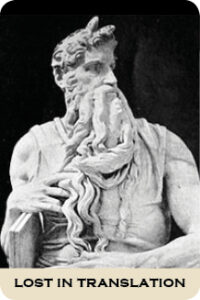 How does repentance fit into your Lenten plans? During Lent, Christians focus on the Passion of Jesus with an eye toward repentance. It’s helpful to know what’s meant by the word. Lost in Translation is an online column that can help readers connect with ideas expressed in the original languages of the Scriptures. Turning to God’s Word author Matthew Phelps examines the relationship between “repentance” and forgiveness of sins. New Lost in Translation entries are posted on Mondays, and past entries are archived on our website. Contact us if you’d like to receive Lost in Translation by email every week.
How does repentance fit into your Lenten plans? During Lent, Christians focus on the Passion of Jesus with an eye toward repentance. It’s helpful to know what’s meant by the word. Lost in Translation is an online column that can help readers connect with ideas expressed in the original languages of the Scriptures. Turning to God’s Word author Matthew Phelps examines the relationship between “repentance” and forgiveness of sins. New Lost in Translation entries are posted on Mondays, and past entries are archived on our website. Contact us if you’d like to receive Lost in Translation by email every week.
WHAT DO YOU THINK about your path to holiness?
When Jesus makes a journey to Calvary, we need to pay close attention. Jesus’ Sorrowful Way is the path to holiness. We’re expected to carry our crosses along the same path.
 ? What steps have you taken to follow Jesus this Lent?
? What steps have you taken to follow Jesus this Lent?
? What obstacles have you encountered?
? Who along your way has offered you support and encouragement?
? Who have you met along your way to whom you can offer support and encouragement?
? Who have you recently encountered who, by their behavior toward you or others, challenged your ideas about looking for God in other people?
? How did you handle that situation?
a season of joy
On March 25 the Church celebrates the solemnity of the Annunciation, which commemorates the angel Gabriel appearing to the Blessed Virgin Mary to tell her that that she has been chosen to become the Mother of Jesus. March 25, which usually falls sometime during Lent, is exactly nine months before Christmas. That the Annunciation is an announcement of great joy is easily understood. Less so is the Church’s understanding of Lent as a season of Joy, especially when we’re watching depictions of Jesus being scourged and carrying his cross. You can learn about  the connection between Scripture and traditional Marian prayers in the Turning to God’s Word Catholic Bible study Scripture & the Rosary: New Testament Mysteries, Old Testament Parallels. No longer in print, free digital lessons from that study rotate throughout the liturgical year on our website.
the connection between Scripture and traditional Marian prayers in the Turning to God’s Word Catholic Bible study Scripture & the Rosary: New Testament Mysteries, Old Testament Parallels. No longer in print, free digital lessons from that study rotate throughout the liturgical year on our website.
other joyful celebrations during Lent
Surprisingly enough, the solemnity of the Annunciation isn’t the only joyful celebration that falls during Lent. The solemnity of St. Joseph is celebrated on March 19. The Benedictine monks at Conception Abbey, where Tami, Matthew, and I all are oblates, celebrate the Transitus of St. Benedict on March 21, the date of their founder’s passing into eternity. And finally, the fourth Sunday in Lent is Laetare Sunday, which is considered a Sunday of Joy at which priests are encouraged to wear rose-colored vestments. This is a lot of religious celebrating in the middle of an otherwise rather austere season. In years in which Easter falls early, the dates of some of these celebrations may fall in the Triduum, and Holy Week liturgical observances override them.
What is there to be joyful about during Lent? The key is found in the Gospel According to John 16:33, in which Jesus tells his disciples: “In the world you have tribulation, but be of good cheer. I have overcome the world.” One of the most interesting things to reflect upon in regard to this statement is that Jesus  makes it prior to his Passion and death. He speaks in the past tense, even though he hasn’t yet been crucified and risen from the dead. That Jesus has overcome the world is a done deal. You can learn more in Lesson 19 When the Spirit of Truth Comes in the Turning to God’s Word Catholic Bible study The Gospel According to John: An Encounter with Grace & Truth.
makes it prior to his Passion and death. He speaks in the past tense, even though he hasn’t yet been crucified and risen from the dead. That Jesus has overcome the world is a done deal. You can learn more in Lesson 19 When the Spirit of Truth Comes in the Turning to God’s Word Catholic Bible study The Gospel According to John: An Encounter with Grace & Truth.
ex libris—learn more about Jesus’ Passion, death & Resurrection

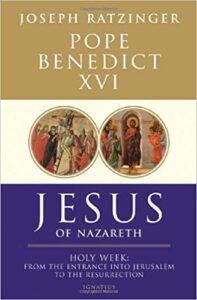 Jesus of Nazareth: Holy Week is one of three books in a series about Jesus in the Gospels. Written by Pope Benedict XVI, it looks at the decisive events that are the focus of Jesus’ last week on earth. The Scripture covered begins with Jesus’ entrance into Jerusalem and continues through the time of his Resurrection. Read excerpts and learn more about the Jesus of Nazareth trilogy and other works related to Bible study at ex libris—main bookshelf.
Jesus of Nazareth: Holy Week is one of three books in a series about Jesus in the Gospels. Written by Pope Benedict XVI, it looks at the decisive events that are the focus of Jesus’ last week on earth. The Scripture covered begins with Jesus’ entrance into Jerusalem and continues through the time of his Resurrection. Read excerpts and learn more about the Jesus of Nazareth trilogy and other works related to Bible study at ex libris—main bookshelf.
the best Catholic commentary about Scripture
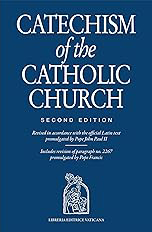 To find out more about how Church teaching is supported by Scripture passages in Jesus’ Passion: The Story of Redemptive Suffering, check out the Index of Citations in the Catechism of the Catholic Church. Links to the primary Scripture passages in the lesson (Revised Standard Version Catholic Edition [RSVCE*]) and relevant paragraphs in the Catechism are provided here. Not every passage in the biblical text for this Catholic Bible study is referenced in a Catechism paragraph, however, including the passage in this lesson from the Gospel According to Mark 15:21–22.
To find out more about how Church teaching is supported by Scripture passages in Jesus’ Passion: The Story of Redemptive Suffering, check out the Index of Citations in the Catechism of the Catholic Church. Links to the primary Scripture passages in the lesson (Revised Standard Version Catholic Edition [RSVCE*]) and relevant paragraphs in the Catechism are provided here. Not every passage in the biblical text for this Catholic Bible study is referenced in a Catechism paragraph, however, including the passage in this lesson from the Gospel According to Mark 15:21–22.
the Gospel According to Matthew 5:43–44—paragraphs 1933, 2844
the Gospel According to Matthew 5:44–45—paragraphs 2303, 2608
the Gospel According to Matthew 5:44—paragraphs 1825, 1968, 2262
the Gospel According to Matthew 5:45—paragraph 2828
the Gospel According to Matthew 5:46—paragraph 2054
the Gospel According to Luke 23:28—paragraph 2635
the Gospel According to Luke 23:34—paragraphs 591, 597, 2605, 2635
the Gospel According to John 10:11–15—paragraph 754
the Gospel According to John 10:16—paragraph 60
the Gospel According to John 10:17–18—paragraphs 614, 649
don’t forget about our indexes & extra online material

 If you’re trying to locate information about a Scripture passage, you can look it up in the index at the back of the online version of this study. If you want to revisit a commentary, you can look it up by title in the topics index. If you want to learn more about another book of the Bible for which there’s a Turning to God’s Word study, you can read online commentaries and watch any accompanying videos by choosing a lesson from one of the study directories. (There are no lesson videos with Jesus’ Passion: The Story of Redemptive Suffering.) Finally, if you have a question or would like to make a comment about any of our studies, you can use the “ask us your question” or “what do you think” button to email our authors.
If you’re trying to locate information about a Scripture passage, you can look it up in the index at the back of the online version of this study. If you want to revisit a commentary, you can look it up by title in the topics index. If you want to learn more about another book of the Bible for which there’s a Turning to God’s Word study, you can read online commentaries and watch any accompanying videos by choosing a lesson from one of the study directories. (There are no lesson videos with Jesus’ Passion: The Story of Redemptive Suffering.) Finally, if you have a question or would like to make a comment about any of our studies, you can use the “ask us your question” or “what do you think” button to email our authors.
ex libris—Church documents & books about religious topics
Link to magisterial documents referred to in our Bible studies at ex libris—magisterial documents.  This listing includes significant recent encyclicals as well as a number of historical Church documents. Recommended books related to Scripture study can be found at ex libris—main bookshelf.
This listing includes significant recent encyclicals as well as a number of historical Church documents. Recommended books related to Scripture study can be found at ex libris—main bookshelf.
wondering how to pronounce some of these words?
The following links are to readings from the New International Version (NIV) Bible. To listen, click on the audio icon above the printed text. Although not taken from the translations used in our study materials, the NIV readings provide an audio guide to pronunciation of words in this lesson’s primary biblical texts. A close online version of the translation of the Bible used in Catholic liturgy in the United States as well as an audio guide for daily Mass readings for the current month can be found on the website of the United States Conference of Catholic Bishops (USCCB).
the Gospel According to Luke 23:26–32 (NIV)
the Gospel According to Mark 15:21–22 (NIV)
the Gospel According to Matthew 5:43–46 (NIV)
the Gospel According to John 10:14–18 (NIV)
close with Bible-based prayer related to this lesson
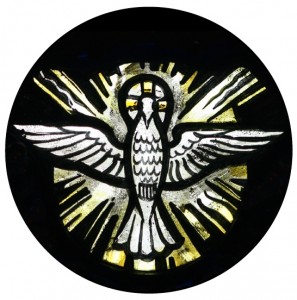 Many groups conclude with a prayer based on Scripture, and some participants include Scripture-specific prayer in their individual study. If you’re uncomfortable composing your own Bible-based prayers, you can follow our four easy steps. If you prefer, you can use the following prayer based on the primary biblical texts that accompany this lesson in Jesus’ Passion: The Story of Redemptive Suffering.
Many groups conclude with a prayer based on Scripture, and some participants include Scripture-specific prayer in their individual study. If you’re uncomfortable composing your own Bible-based prayers, you can follow our four easy steps. If you prefer, you can use the following prayer based on the primary biblical texts that accompany this lesson in Jesus’ Passion: The Story of Redemptive Suffering.
Our Father in heaven, you gave your Son
the power to lay down his life and take it again.
Help us to love our enemies, to pray for those who persecute us,
and to realize that the kindness we extend to others
we really give to you.
We ask this in union with the Holy Spirit
and in the name of your Son, the Good Shepherd,
who laid down his life for the sheep. Amen.
 coming up in the next lesson
coming up in the next lesson
The online study page for Lesson 5 Crucifixion, Death & Resurrection in Jesus’ Passion: The Story of Redemptive Suffering contains additional commentary, questions, and links to other related material. The lesson roughly corresponds to the final 25 minutes of the film The Passion of the Christ. Links to the free digital version of the study will remain posted through Lent this year, and all of the lessons will be available again during Lent in 2025.
Lesson 5 Crucifixion, Death & Resurrection—the Gospel According to Matthew 26:26–29 and the Gospel According to John 19:17—20:8
Lesson 3 What Is Truth?—the Gospel According to John 18:33—19:16 and the Gospel According to Matthew 27:15–31
you also may like our study of Scripture & the Rosary (digital only)
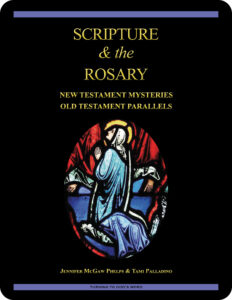 Scripture & the Rosary: New Testament Mysteries, Old Testament Parallels, a 26-lesson Catholic Bible study with an imprimatur, looks at the biblical foundations of the Rosary. The study includes lessons on Pope St. John Paul II’s Rosarium Virginis Mariae (Rosary of the Virgin Mary), the Apostles’ Creed, and the Luminous Mysteries as well as the original 15 Mysteries of the Rosary. Color photographs of stained glass windows depict key scenes in the lives of Jesus and Mary. Free digital lessons rotate throughout the year on our website.
Scripture & the Rosary: New Testament Mysteries, Old Testament Parallels, a 26-lesson Catholic Bible study with an imprimatur, looks at the biblical foundations of the Rosary. The study includes lessons on Pope St. John Paul II’s Rosarium Virginis Mariae (Rosary of the Virgin Mary), the Apostles’ Creed, and the Luminous Mysteries as well as the original 15 Mysteries of the Rosary. Color photographs of stained glass windows depict key scenes in the lives of Jesus and Mary. Free digital lessons rotate throughout the year on our website.
start a Turning to God’s Word Bible study
Thank you for your interest in Jesus’ Passion: The Story of Redemptive Suffering,  our annual free Lenten
our annual free Lenten  Bible study. Lessons can be downloaded from our website through Easter. Information about beginning a group study can be found at start a Bible study. Tami, Matthew, and I are available to answer questions about the Turning to God’s Word method of Catholic Bible study. You may use this email to contact us directly if you’re interested in starting another Turning to God study or in having your study schedule listed with other TtGW study groups on our website. —Jennifer
Bible study. Lessons can be downloaded from our website through Easter. Information about beginning a group study can be found at start a Bible study. Tami, Matthew, and I are available to answer questions about the Turning to God’s Word method of Catholic Bible study. You may use this email to contact us directly if you’re interested in starting another Turning to God study or in having your study schedule listed with other TtGW study groups on our website. —Jennifer
*There are seven deuterocanonical books in the Old Testament—the Books of Tobit, Judith, Wisdom, Sirach, Baruch, and First and Second Maccabees, as well as some passages in the Books of Esther and Daniel. Protestants usually refer to these works as “apocryphal,” a word that means “outside the (Protestant) canon” because they’re excluded from most Protestant Bibles. The word “deuterocanonical” means “second canon”; Catholics use that word to refer to any section of the Catholic Old Testament for which there are no extant, or existing, Hebrew manuscripts. All of the deuterocanonical books appear in the Septuagint, the earliest remaining versions of which date to the 1st century B.C. This Greek translation of the Old Testament was in common use by Jews at the time of Jesus. Learn more by reading How Do Catholic & Protestant Bibles Differ?
Turning to God’s Word printed Bible studies use the 2006 Revised Standard Version Second Catholic Edition (RSV2CE) translation for all Scripture references except those to the Psalms, which are taken from The Abbey Psalms and Canticles, prepared by the Benedictine monks of Conception Abbey and published in 2020 by the United States Conference of Catholic Bishops (USCCB). All Scripture links for the digital version of Jesus’ Passion: The Story of Redemptive Suffering are to the 1966 Revised Standard Version Catholic Edition (RSVCE) translation. The New International Version (NIV) audio recordings follow the same chapter and verse numbering as the RSV Catholic translations, but the NIV translation doesn’t include the deuterocanonical books and passages.
The 1966 RSVCE uses archaic pronouns and verb forms such as “thee,” “thou,” “didst” in the Psalms and in direct quotations attributed to God. The 2006 RSV2CE replaces these with more accessible English. The few significant translation changes in the RSV2CE include rendering almah as “virgin” in the Book of Isaiah 7:14 and restoring the term “begotten” in the Gospel According to John 3:16.
Numbering varies for some passages in this Bible study. Turning to God’s Word studies follow the numbering in the Revised Standard Version Catholic translations (RSV2CE and RSVCE). Discrepancies in the New American Bible Revised Edition (NABRE) are noted in the Index of Scripture Citations.
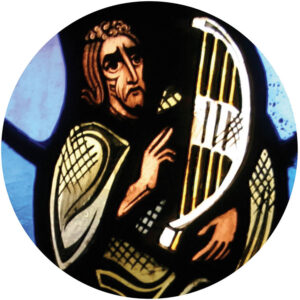 You can learn more about the Psalms by viewing a sample lesson from the Turning to God’s Word Catholic Bible study Sing a New Psalm: Communicating with God Through the Prayers of the Church—Volume I: Lauds & Vespers. The second part of that study, Sing a New Psalm: Communicating with God Through the Prayers of the Church—Volume II: Vigils, Day Prayer & Compline, is scheduled for publication in 2025. Some verse numbers may vary in different translations of the Psalms.
You can learn more about the Psalms by viewing a sample lesson from the Turning to God’s Word Catholic Bible study Sing a New Psalm: Communicating with God Through the Prayers of the Church—Volume I: Lauds & Vespers. The second part of that study, Sing a New Psalm: Communicating with God Through the Prayers of the Church—Volume II: Vigils, Day Prayer & Compline, is scheduled for publication in 2025. Some verse numbers may vary in different translations of the Psalms.
**The Gospel According to John 3:16 (RSV2CE) reads: “For God so loved the world that he gave his only-begotten Son, that whoever believes in him should not perish but have eternal life.”
